Leadership, Motivation, Teamwork: An Organisational Analysis Report
VerifiedAdded on 2020/01/21
|18
|4185
|48
Report
AI Summary
This report delves into the impact of various leadership styles, including democratic, autocratic, laissez-faire, and paternalistic, on employee motivation, especially during periods of organizational change. It compares the application of different motivational theories such as Maslow's hierarchy of needs, Herzberg's two-factor theory, McGregor's Theory X and Y, and Vroom's expectancy theory within the workplace, evaluating their usefulness for managers. The report further explores the nature of groups and group behavior in organizations, discussing factors that promote or hinder effective teamwork and assessing the impact of technology on team functioning. It emphasizes the importance of understanding individual needs, creating a supportive work environment, and aligning leadership approaches with organizational goals to enhance employee performance and achieve desired outcomes.
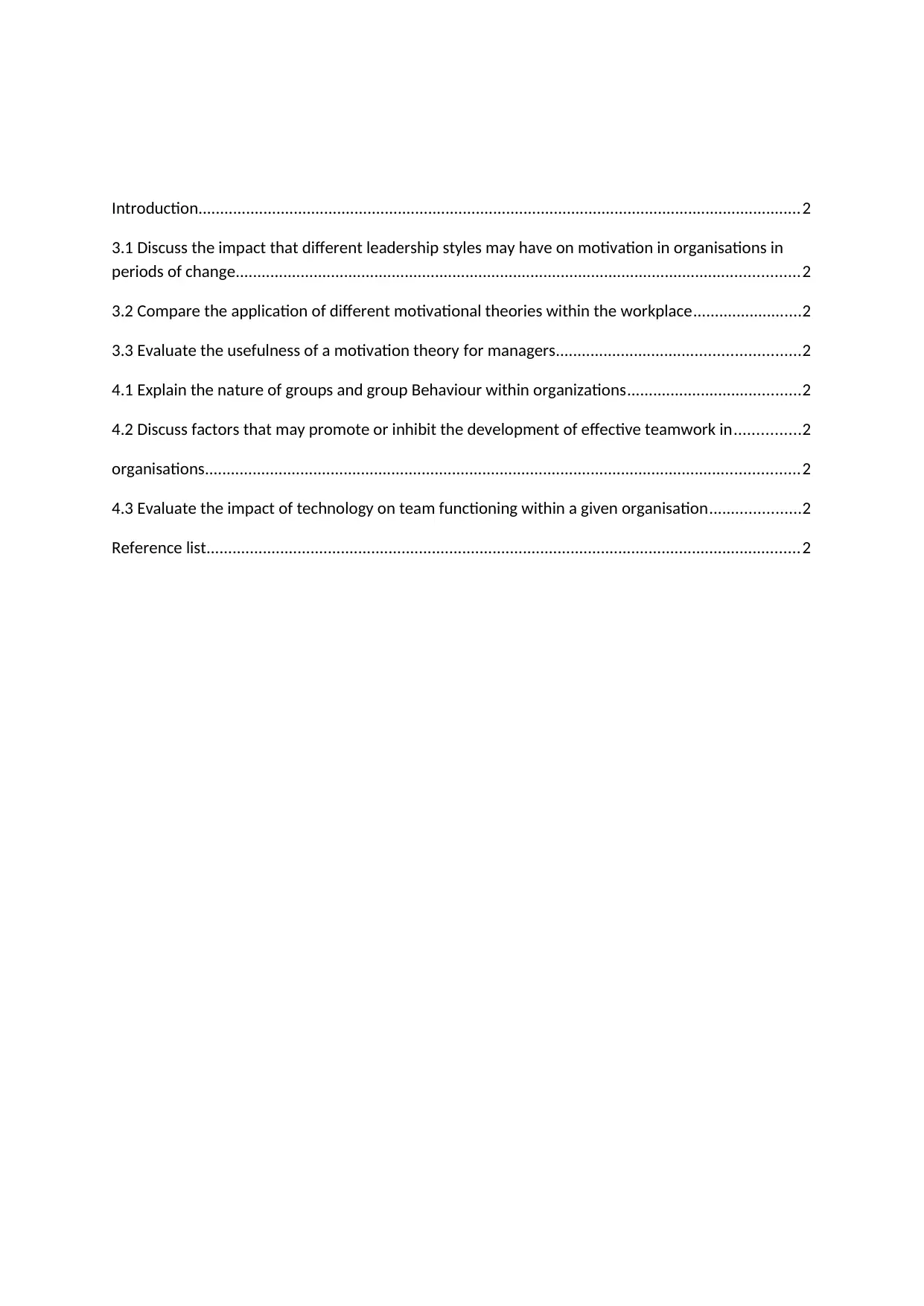
Introduction...........................................................................................................................................2
3.1 Discuss the impact that different leadership styles may have on motivation in organisations in
periods of change..................................................................................................................................2
3.2 Compare the application of different motivational theories within the workplace.........................2
3.3 Evaluate the usefulness of a motivation theory for managers........................................................2
4.1 Explain the nature of groups and group Behaviour within organizations........................................2
4.2 Discuss factors that may promote or inhibit the development of effective teamwork in...............2
organisations.........................................................................................................................................2
4.3 Evaluate the impact of technology on team functioning within a given organisation.....................2
Reference list.........................................................................................................................................2
3.1 Discuss the impact that different leadership styles may have on motivation in organisations in
periods of change..................................................................................................................................2
3.2 Compare the application of different motivational theories within the workplace.........................2
3.3 Evaluate the usefulness of a motivation theory for managers........................................................2
4.1 Explain the nature of groups and group Behaviour within organizations........................................2
4.2 Discuss factors that may promote or inhibit the development of effective teamwork in...............2
organisations.........................................................................................................................................2
4.3 Evaluate the impact of technology on team functioning within a given organisation.....................2
Reference list.........................................................................................................................................2
Paraphrase This Document
Need a fresh take? Get an instant paraphrase of this document with our AI Paraphraser
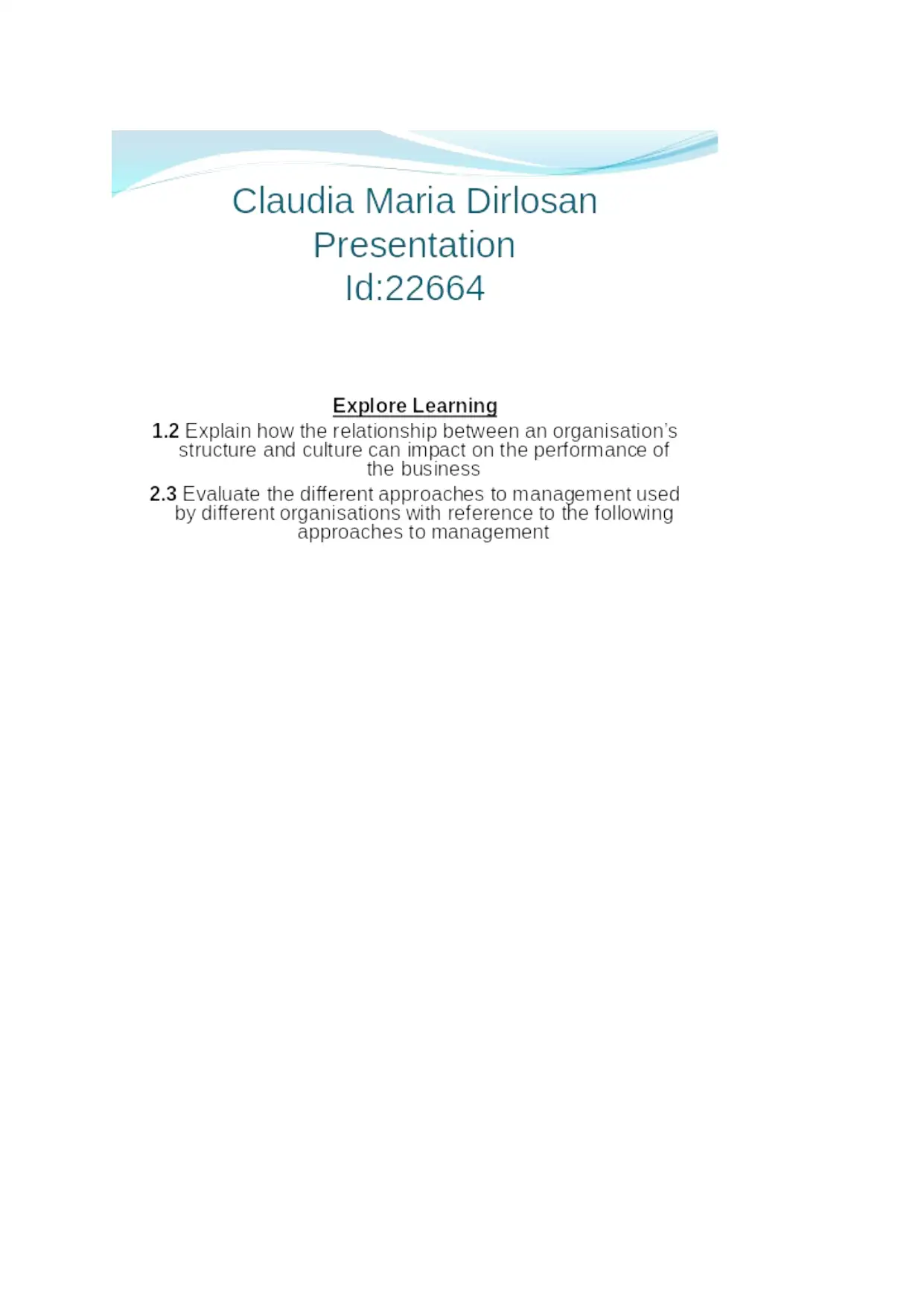
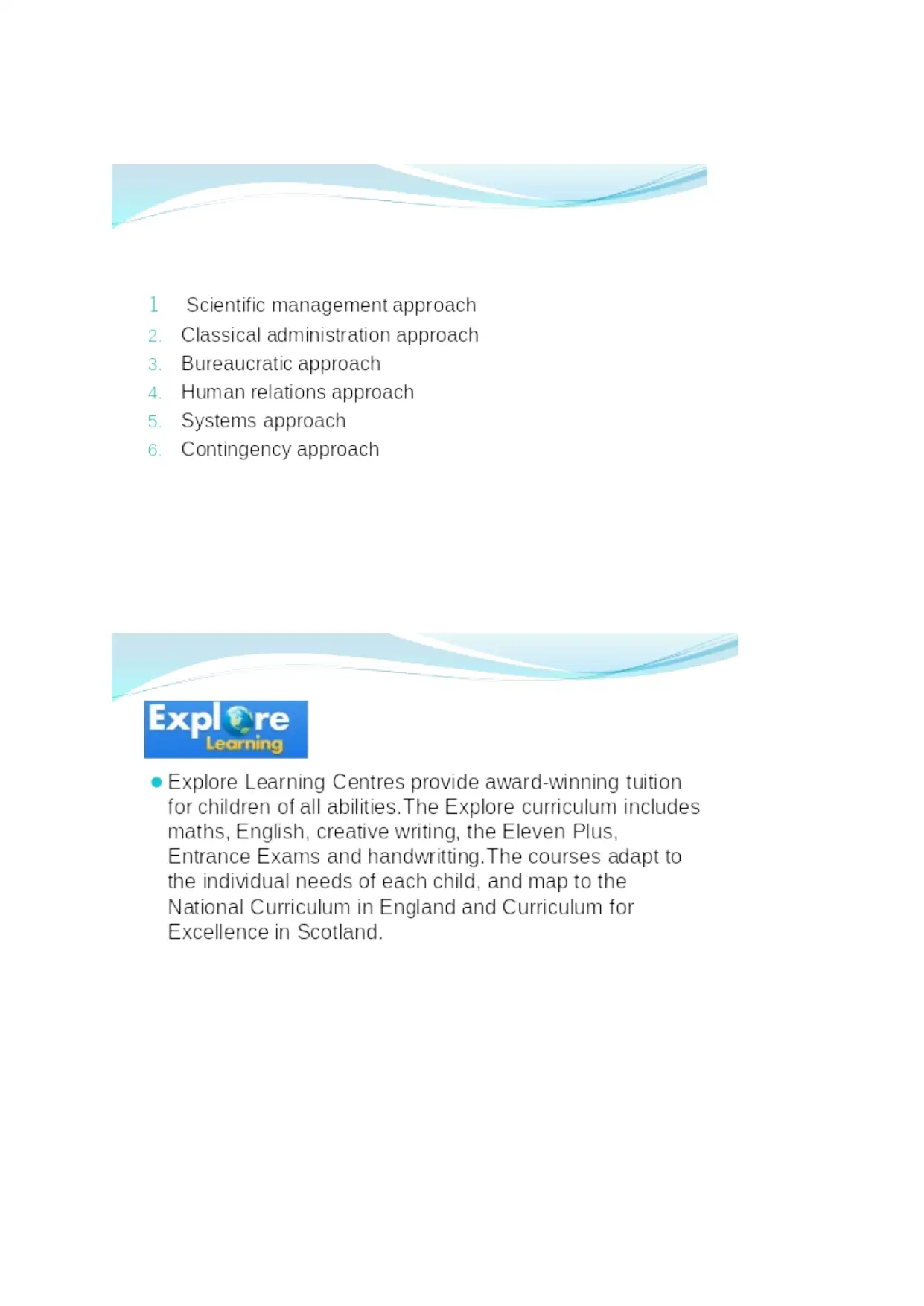
⊘ This is a preview!⊘
Do you want full access?
Subscribe today to unlock all pages.

Trusted by 1+ million students worldwide
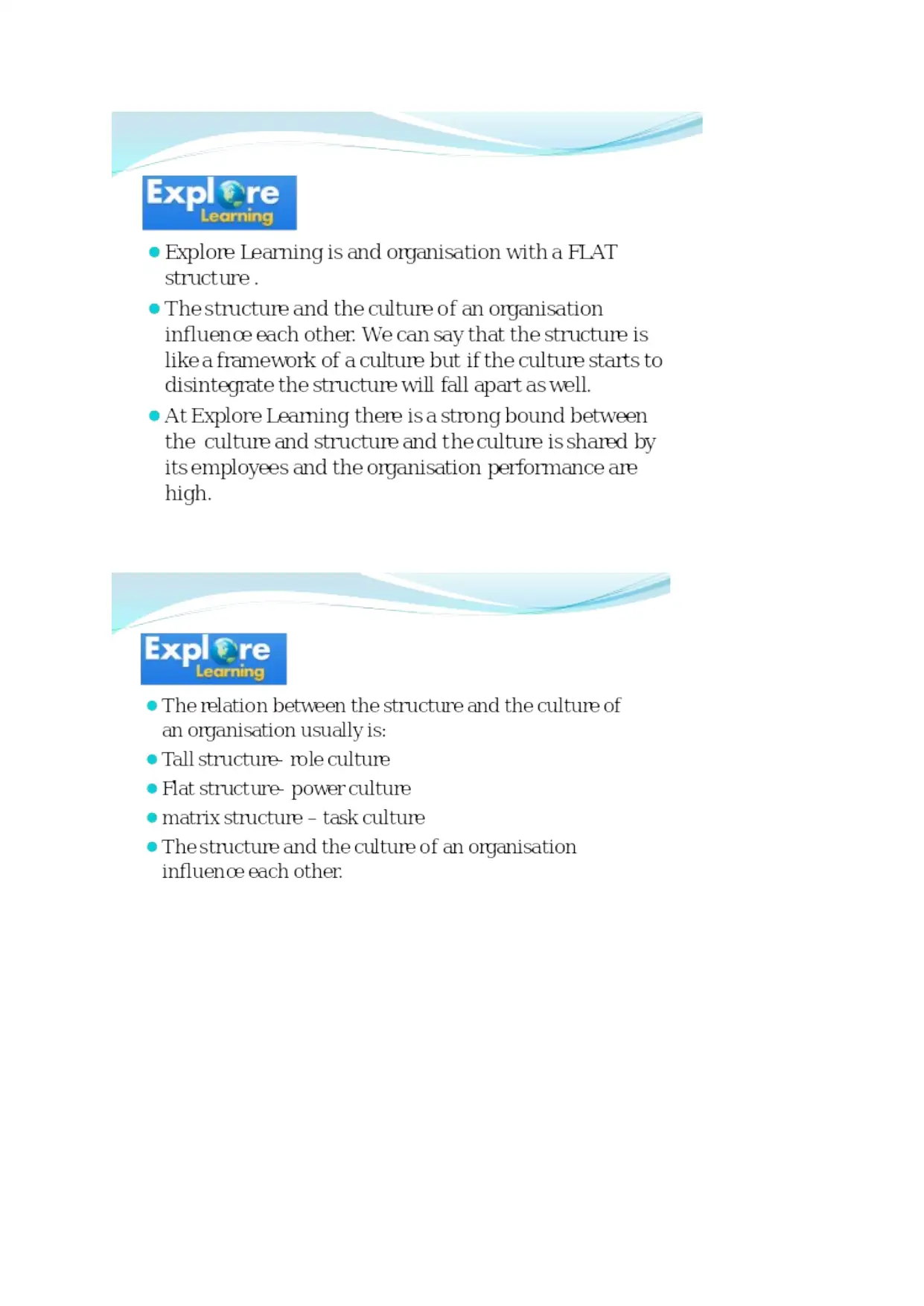
Paraphrase This Document
Need a fresh take? Get an instant paraphrase of this document with our AI Paraphraser
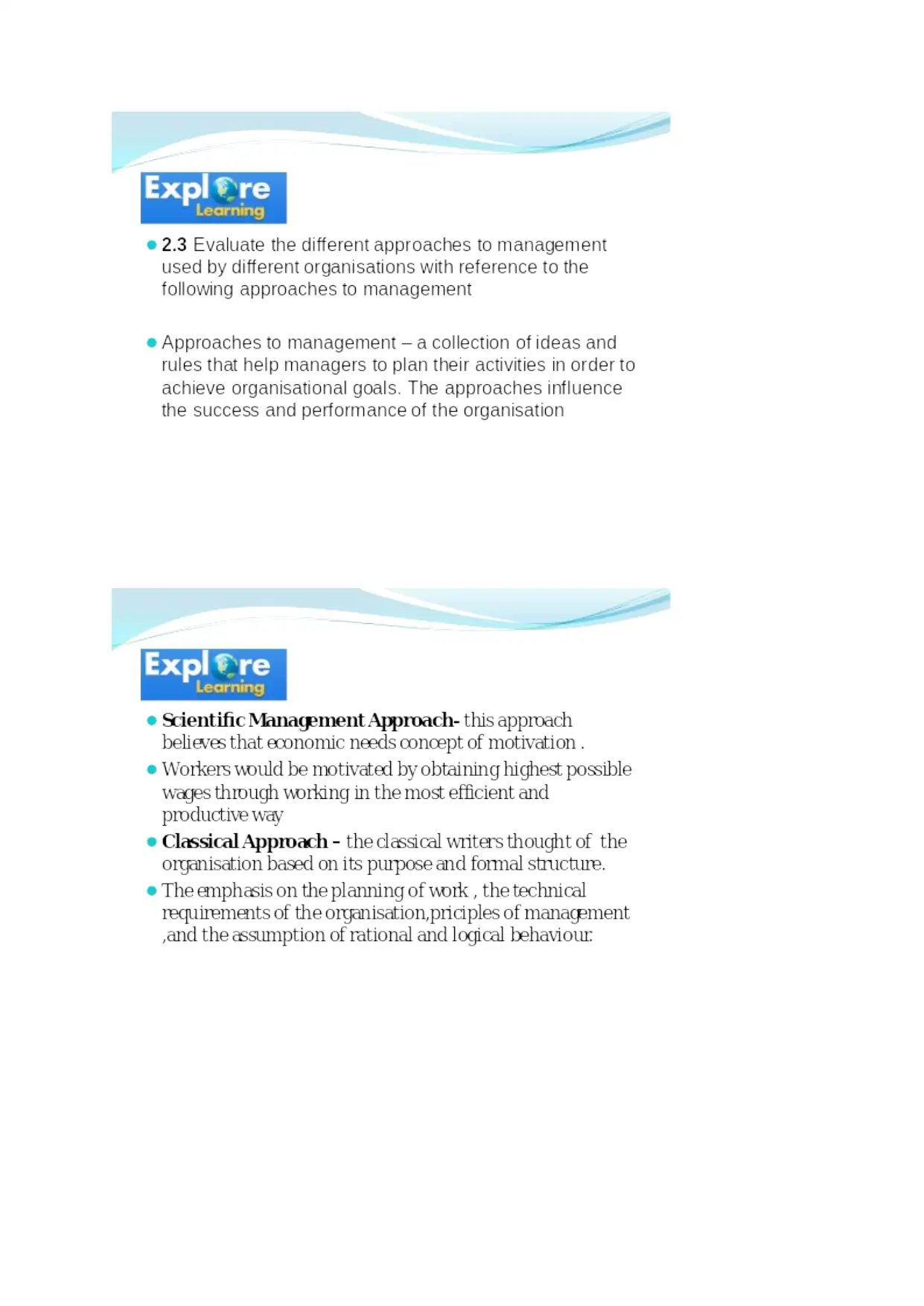
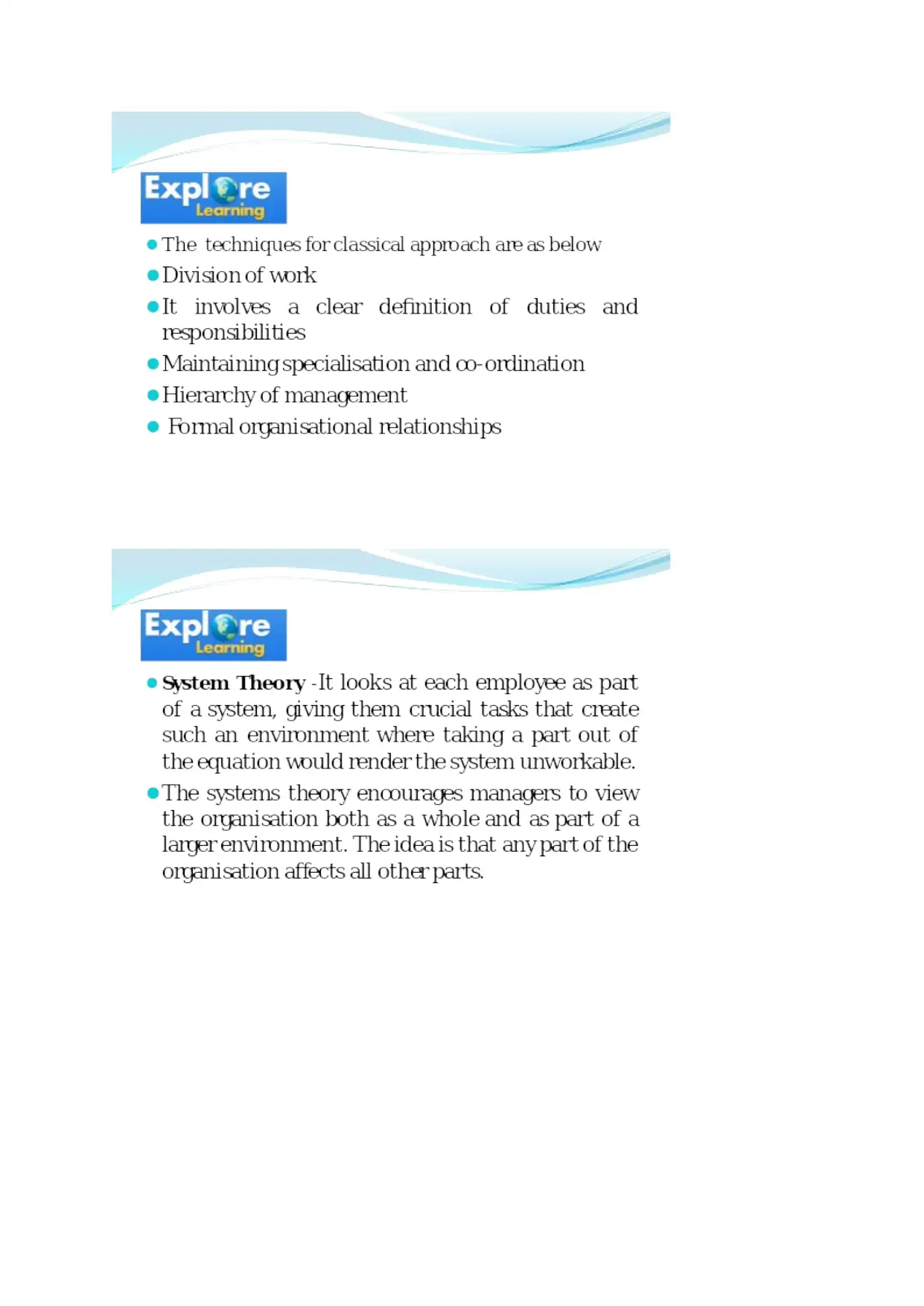
⊘ This is a preview!⊘
Do you want full access?
Subscribe today to unlock all pages.

Trusted by 1+ million students worldwide
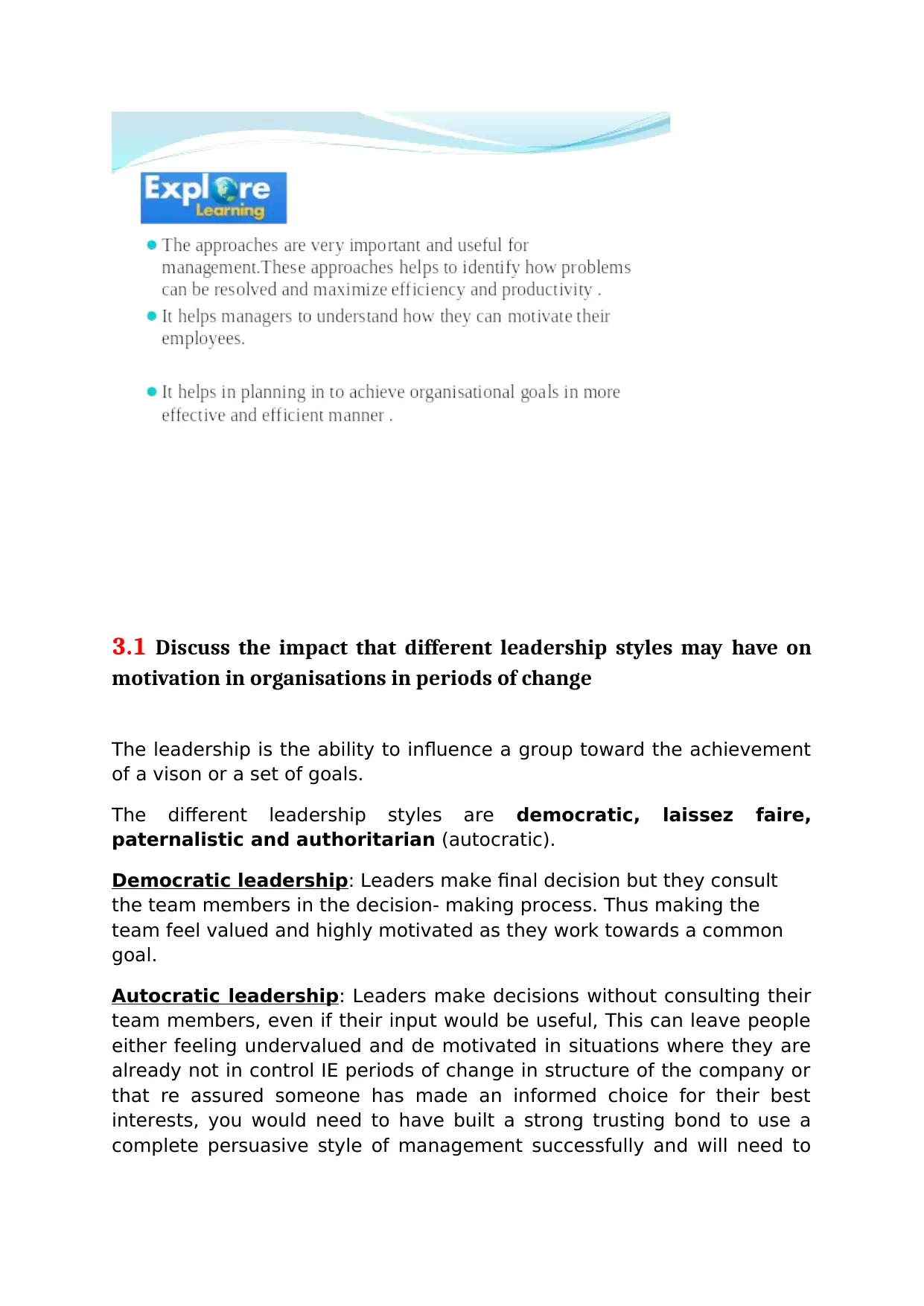
3.1 Discuss the impact that different leadership styles may have on
motivation in organisations in periods of change
The leadership is the ability to influence a group toward the achievement
of a vison or a set of goals.
The different leadership styles are democratic, laissez faire,
paternalistic and authoritarian (autocratic).
Democratic leadership: Leaders make final decision but they consult
the team members in the decision- making process. Thus making the
team feel valued and highly motivated as they work towards a common
goal.
Autocratic leadership: Leaders make decisions without consulting their
team members, even if their input would be useful, This can leave people
either feeling undervalued and de motivated in situations where they are
already not in control IE periods of change in structure of the company or
that re assured someone has made an informed choice for their best
interests, you would need to have built a strong trusting bond to use a
complete persuasive style of management successfully and will need to
motivation in organisations in periods of change
The leadership is the ability to influence a group toward the achievement
of a vison or a set of goals.
The different leadership styles are democratic, laissez faire,
paternalistic and authoritarian (autocratic).
Democratic leadership: Leaders make final decision but they consult
the team members in the decision- making process. Thus making the
team feel valued and highly motivated as they work towards a common
goal.
Autocratic leadership: Leaders make decisions without consulting their
team members, even if their input would be useful, This can leave people
either feeling undervalued and de motivated in situations where they are
already not in control IE periods of change in structure of the company or
that re assured someone has made an informed choice for their best
interests, you would need to have built a strong trusting bond to use a
complete persuasive style of management successfully and will need to
Paraphrase This Document
Need a fresh take? Get an instant paraphrase of this document with our AI Paraphraser
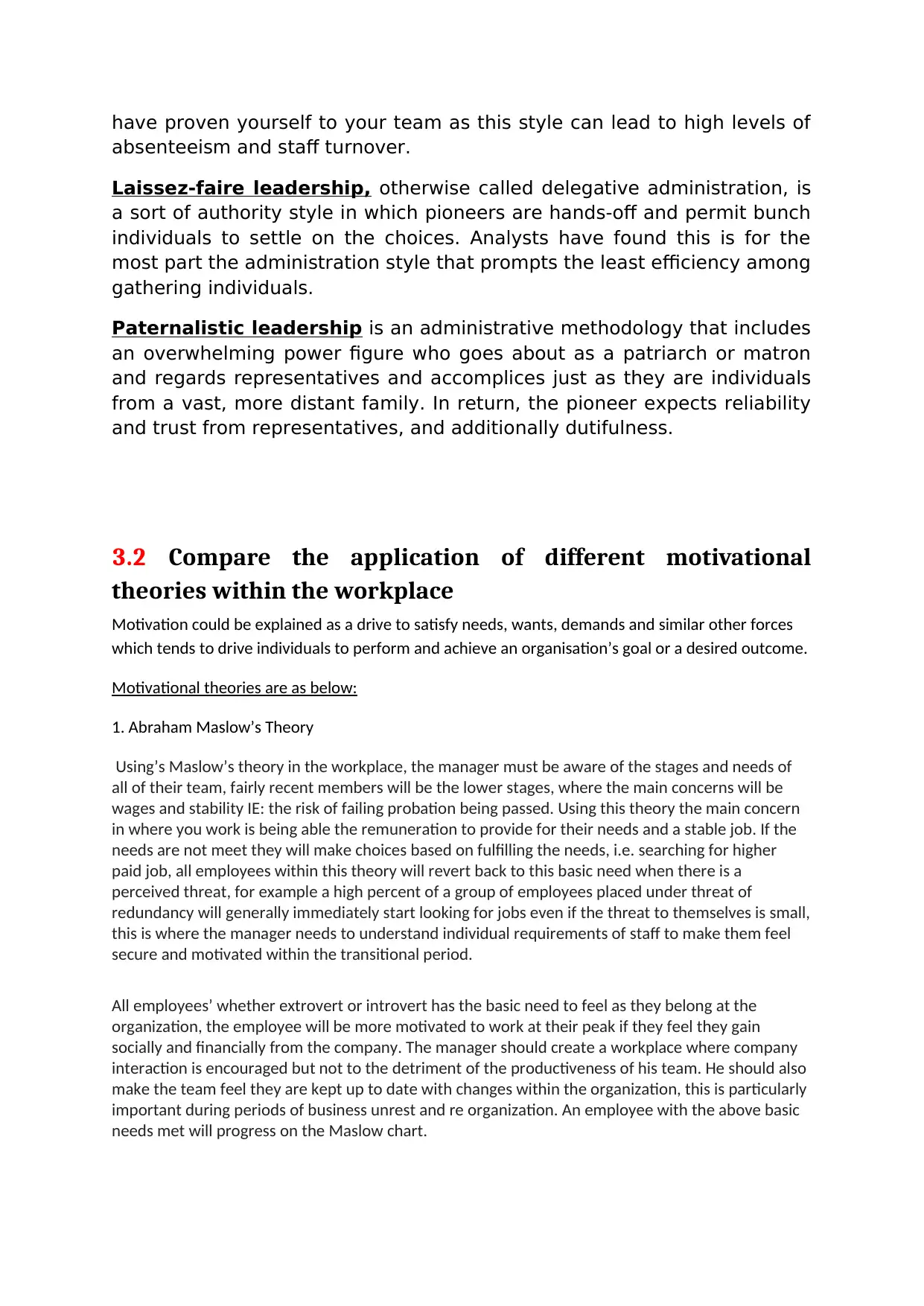
have proven yourself to your team as this style can lead to high levels of
absenteeism and staff turnover.
Laissez-faire leadership, otherwise called delegative administration, is
a sort of authority style in which pioneers are hands-off and permit bunch
individuals to settle on the choices. Analysts have found this is for the
most part the administration style that prompts the least efficiency among
gathering individuals.
Paternalistic leadership is an administrative methodology that includes
an overwhelming power figure who goes about as a patriarch or matron
and regards representatives and accomplices just as they are individuals
from a vast, more distant family. In return, the pioneer expects reliability
and trust from representatives, and additionally dutifulness.
3.2 Compare the application of different motivational
theories within the workplace
Motivation could be explained as a drive to satisfy needs, wants, demands and similar other forces
which tends to drive individuals to perform and achieve an organisation’s goal or a desired outcome.
Motivational theories are as below:
1. Abraham Maslow’s Theory
Using’s Maslow’s theory in the workplace, the manager must be aware of the stages and needs of
all of their team, fairly recent members will be the lower stages, where the main concerns will be
wages and stability IE: the risk of failing probation being passed. Using this theory the main concern
in where you work is being able the remuneration to provide for their needs and a stable job. If the
needs are not meet they will make choices based on fulfilling the needs, i.e. searching for higher
paid job, all employees within this theory will revert back to this basic need when there is a
perceived threat, for example a high percent of a group of employees placed under threat of
redundancy will generally immediately start looking for jobs even if the threat to themselves is small,
this is where the manager needs to understand individual requirements of staff to make them feel
secure and motivated within the transitional period.
All employees’ whether extrovert or introvert has the basic need to feel as they belong at the
organization, the employee will be more motivated to work at their peak if they feel they gain
socially and financially from the company. The manager should create a workplace where company
interaction is encouraged but not to the detriment of the productiveness of his team. He should also
make the team feel they are kept up to date with changes within the organization, this is particularly
important during periods of business unrest and re organization. An employee with the above basic
needs met will progress on the Maslow chart.
absenteeism and staff turnover.
Laissez-faire leadership, otherwise called delegative administration, is
a sort of authority style in which pioneers are hands-off and permit bunch
individuals to settle on the choices. Analysts have found this is for the
most part the administration style that prompts the least efficiency among
gathering individuals.
Paternalistic leadership is an administrative methodology that includes
an overwhelming power figure who goes about as a patriarch or matron
and regards representatives and accomplices just as they are individuals
from a vast, more distant family. In return, the pioneer expects reliability
and trust from representatives, and additionally dutifulness.
3.2 Compare the application of different motivational
theories within the workplace
Motivation could be explained as a drive to satisfy needs, wants, demands and similar other forces
which tends to drive individuals to perform and achieve an organisation’s goal or a desired outcome.
Motivational theories are as below:
1. Abraham Maslow’s Theory
Using’s Maslow’s theory in the workplace, the manager must be aware of the stages and needs of
all of their team, fairly recent members will be the lower stages, where the main concerns will be
wages and stability IE: the risk of failing probation being passed. Using this theory the main concern
in where you work is being able the remuneration to provide for their needs and a stable job. If the
needs are not meet they will make choices based on fulfilling the needs, i.e. searching for higher
paid job, all employees within this theory will revert back to this basic need when there is a
perceived threat, for example a high percent of a group of employees placed under threat of
redundancy will generally immediately start looking for jobs even if the threat to themselves is small,
this is where the manager needs to understand individual requirements of staff to make them feel
secure and motivated within the transitional period.
All employees’ whether extrovert or introvert has the basic need to feel as they belong at the
organization, the employee will be more motivated to work at their peak if they feel they gain
socially and financially from the company. The manager should create a workplace where company
interaction is encouraged but not to the detriment of the productiveness of his team. He should also
make the team feel they are kept up to date with changes within the organization, this is particularly
important during periods of business unrest and re organization. An employee with the above basic
needs met will progress on the Maslow chart.
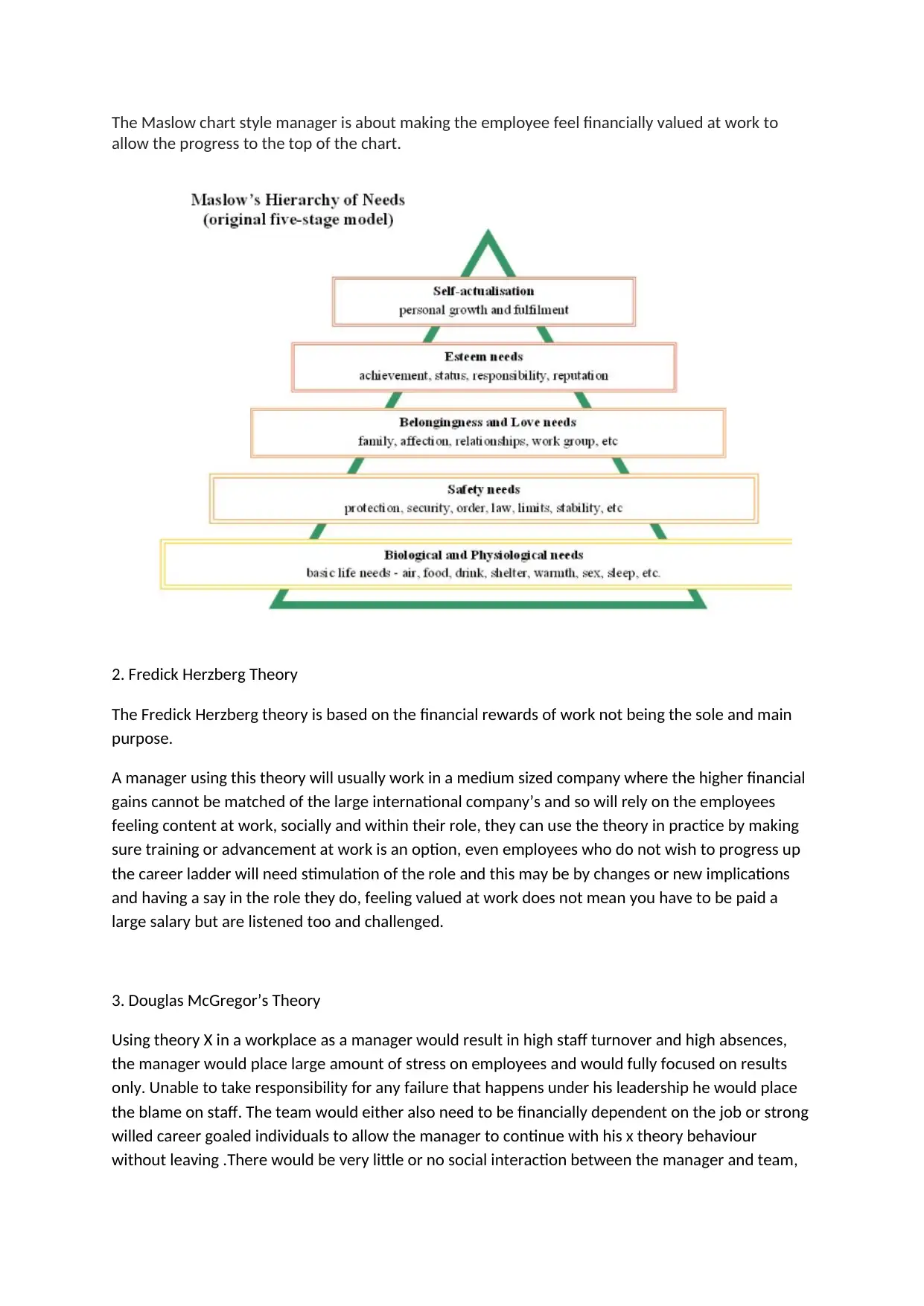
The Maslow chart style manager is about making the employee feel financially valued at work to
allow the progress to the top of the chart.
2. Fredick Herzberg Theory
The Fredick Herzberg theory is based on the financial rewards of work not being the sole and main
purpose.
A manager using this theory will usually work in a medium sized company where the higher financial
gains cannot be matched of the large international company’s and so will rely on the employees
feeling content at work, socially and within their role, they can use the theory in practice by making
sure training or advancement at work is an option, even employees who do not wish to progress up
the career ladder will need stimulation of the role and this may be by changes or new implications
and having a say in the role they do, feeling valued at work does not mean you have to be paid a
large salary but are listened too and challenged.
3. Douglas McGregor’s Theory
Using theory X in a workplace as a manager would result in high staff turnover and high absences,
the manager would place large amount of stress on employees and would fully focused on results
only. Unable to take responsibility for any failure that happens under his leadership he would place
the blame on staff. The team would either also need to be financially dependent on the job or strong
willed career goaled individuals to allow the manager to continue with his x theory behaviour
without leaving .There would be very little or no social interaction between the manager and team,
allow the progress to the top of the chart.
2. Fredick Herzberg Theory
The Fredick Herzberg theory is based on the financial rewards of work not being the sole and main
purpose.
A manager using this theory will usually work in a medium sized company where the higher financial
gains cannot be matched of the large international company’s and so will rely on the employees
feeling content at work, socially and within their role, they can use the theory in practice by making
sure training or advancement at work is an option, even employees who do not wish to progress up
the career ladder will need stimulation of the role and this may be by changes or new implications
and having a say in the role they do, feeling valued at work does not mean you have to be paid a
large salary but are listened too and challenged.
3. Douglas McGregor’s Theory
Using theory X in a workplace as a manager would result in high staff turnover and high absences,
the manager would place large amount of stress on employees and would fully focused on results
only. Unable to take responsibility for any failure that happens under his leadership he would place
the blame on staff. The team would either also need to be financially dependent on the job or strong
willed career goaled individuals to allow the manager to continue with his x theory behaviour
without leaving .There would be very little or no social interaction between the manager and team,
⊘ This is a preview!⊘
Do you want full access?
Subscribe today to unlock all pages.

Trusted by 1+ million students worldwide
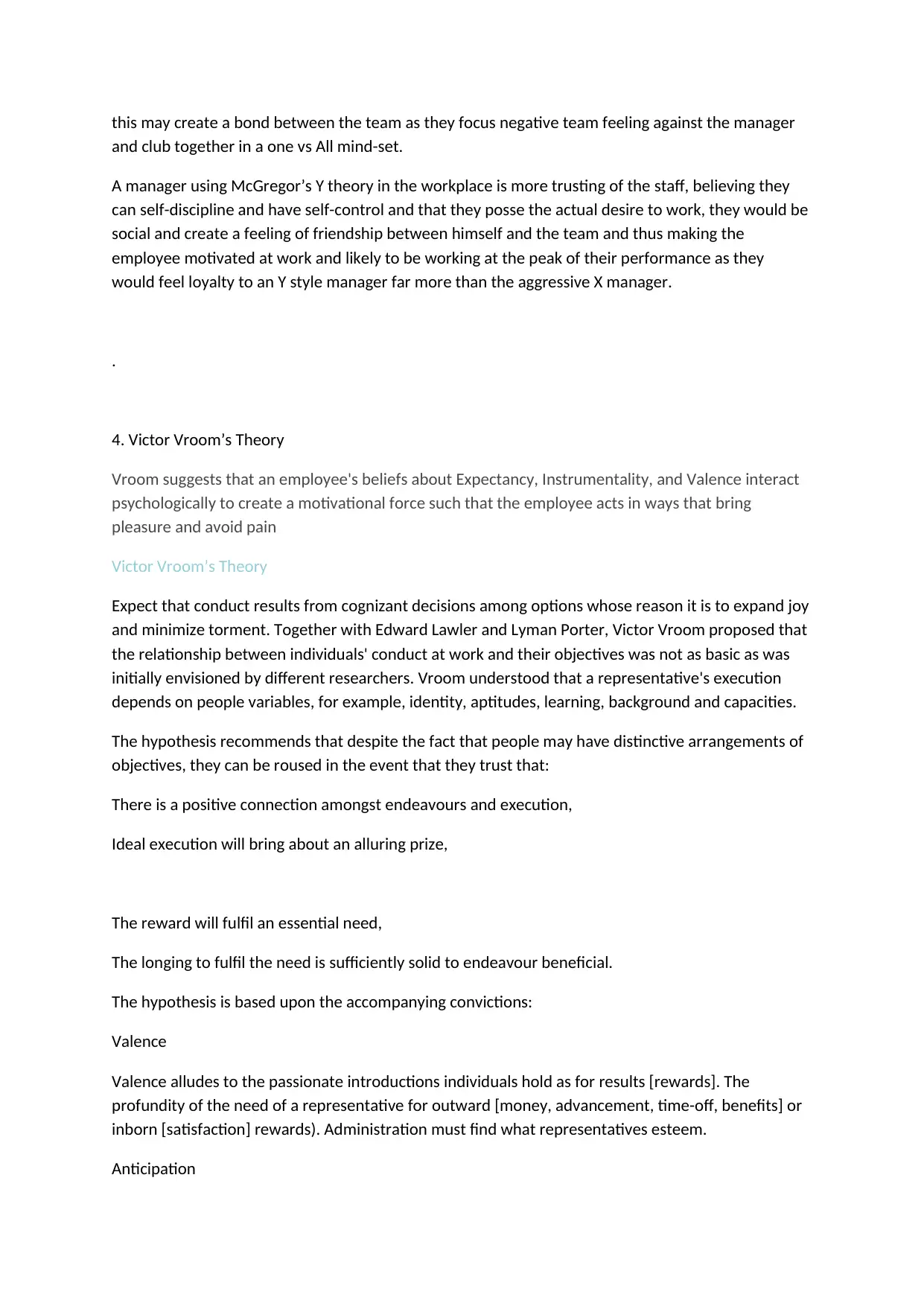
this may create a bond between the team as they focus negative team feeling against the manager
and club together in a one vs All mind-set.
A manager using McGregor’s Y theory in the workplace is more trusting of the staff, believing they
can self-discipline and have self-control and that they posse the actual desire to work, they would be
social and create a feeling of friendship between himself and the team and thus making the
employee motivated at work and likely to be working at the peak of their performance as they
would feel loyalty to an Y style manager far more than the aggressive X manager.
.
4. Victor Vroom’s Theory
Vroom suggests that an employee's beliefs about Expectancy, Instrumentality, and Valence interact
psychologically to create a motivational force such that the employee acts in ways that bring
pleasure and avoid pain
Victor Vroom’s Theory
Expect that conduct results from cognizant decisions among options whose reason it is to expand joy
and minimize torment. Together with Edward Lawler and Lyman Porter, Victor Vroom proposed that
the relationship between individuals' conduct at work and their objectives was not as basic as was
initially envisioned by different researchers. Vroom understood that a representative's execution
depends on people variables, for example, identity, aptitudes, learning, background and capacities.
The hypothesis recommends that despite the fact that people may have distinctive arrangements of
objectives, they can be roused in the event that they trust that:
There is a positive connection amongst endeavours and execution,
Ideal execution will bring about an alluring prize,
The reward will fulfil an essential need,
The longing to fulfil the need is sufficiently solid to endeavour beneficial.
The hypothesis is based upon the accompanying convictions:
Valence
Valence alludes to the passionate introductions individuals hold as for results [rewards]. The
profundity of the need of a representative for outward [money, advancement, time-off, benefits] or
inborn [satisfaction] rewards). Administration must find what representatives esteem.
Anticipation
and club together in a one vs All mind-set.
A manager using McGregor’s Y theory in the workplace is more trusting of the staff, believing they
can self-discipline and have self-control and that they posse the actual desire to work, they would be
social and create a feeling of friendship between himself and the team and thus making the
employee motivated at work and likely to be working at the peak of their performance as they
would feel loyalty to an Y style manager far more than the aggressive X manager.
.
4. Victor Vroom’s Theory
Vroom suggests that an employee's beliefs about Expectancy, Instrumentality, and Valence interact
psychologically to create a motivational force such that the employee acts in ways that bring
pleasure and avoid pain
Victor Vroom’s Theory
Expect that conduct results from cognizant decisions among options whose reason it is to expand joy
and minimize torment. Together with Edward Lawler and Lyman Porter, Victor Vroom proposed that
the relationship between individuals' conduct at work and their objectives was not as basic as was
initially envisioned by different researchers. Vroom understood that a representative's execution
depends on people variables, for example, identity, aptitudes, learning, background and capacities.
The hypothesis recommends that despite the fact that people may have distinctive arrangements of
objectives, they can be roused in the event that they trust that:
There is a positive connection amongst endeavours and execution,
Ideal execution will bring about an alluring prize,
The reward will fulfil an essential need,
The longing to fulfil the need is sufficiently solid to endeavour beneficial.
The hypothesis is based upon the accompanying convictions:
Valence
Valence alludes to the passionate introductions individuals hold as for results [rewards]. The
profundity of the need of a representative for outward [money, advancement, time-off, benefits] or
inborn [satisfaction] rewards). Administration must find what representatives esteem.
Anticipation
Paraphrase This Document
Need a fresh take? Get an instant paraphrase of this document with our AI Paraphraser
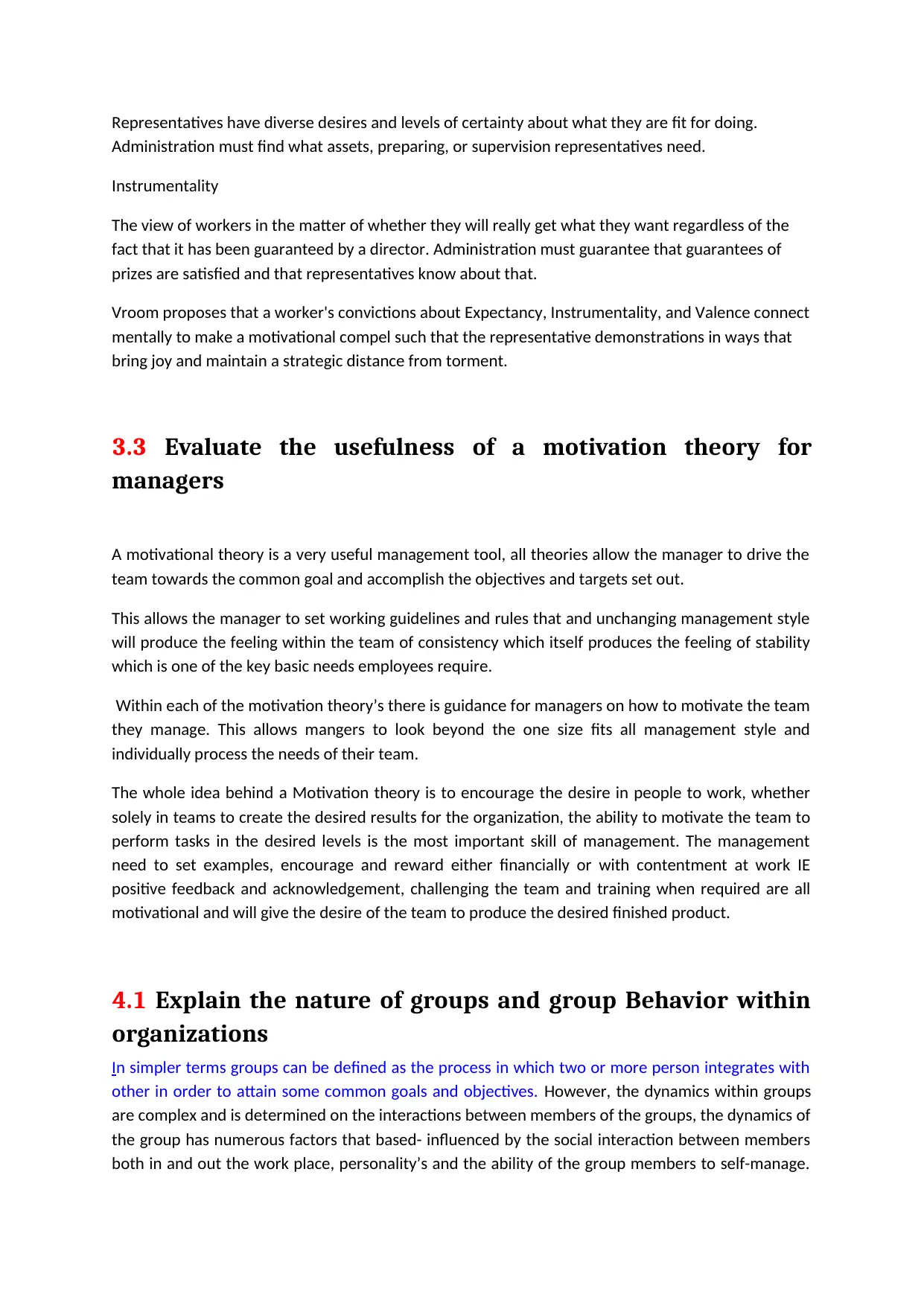
Representatives have diverse desires and levels of certainty about what they are fit for doing.
Administration must find what assets, preparing, or supervision representatives need.
Instrumentality
The view of workers in the matter of whether they will really get what they want regardless of the
fact that it has been guaranteed by a director. Administration must guarantee that guarantees of
prizes are satisfied and that representatives know about that.
Vroom proposes that a worker's convictions about Expectancy, Instrumentality, and Valence connect
mentally to make a motivational compel such that the representative demonstrations in ways that
bring joy and maintain a strategic distance from torment.
3.3 Evaluate the usefulness of a motivation theory for
managers
A motivational theory is a very useful management tool, all theories allow the manager to drive the
team towards the common goal and accomplish the objectives and targets set out.
This allows the manager to set working guidelines and rules that and unchanging management style
will produce the feeling within the team of consistency which itself produces the feeling of stability
which is one of the key basic needs employees require.
Within each of the motivation theory’s there is guidance for managers on how to motivate the team
they manage. This allows mangers to look beyond the one size fits all management style and
individually process the needs of their team.
The whole idea behind a Motivation theory is to encourage the desire in people to work, whether
solely in teams to create the desired results for the organization, the ability to motivate the team to
perform tasks in the desired levels is the most important skill of management. The management
need to set examples, encourage and reward either financially or with contentment at work IE
positive feedback and acknowledgement, challenging the team and training when required are all
motivational and will give the desire of the team to produce the desired finished product.
4.1 Explain the nature of groups and group Behavior within
organizations
In simpler terms groups can be defined as the process in which two or more person integrates with
other in order to attain some common goals and objectives. However, the dynamics within groups
are complex and is determined on the interactions between members of the groups, the dynamics of
the group has numerous factors that based- influenced by the social interaction between members
both in and out the work place, personality’s and the ability of the group members to self-manage.
Administration must find what assets, preparing, or supervision representatives need.
Instrumentality
The view of workers in the matter of whether they will really get what they want regardless of the
fact that it has been guaranteed by a director. Administration must guarantee that guarantees of
prizes are satisfied and that representatives know about that.
Vroom proposes that a worker's convictions about Expectancy, Instrumentality, and Valence connect
mentally to make a motivational compel such that the representative demonstrations in ways that
bring joy and maintain a strategic distance from torment.
3.3 Evaluate the usefulness of a motivation theory for
managers
A motivational theory is a very useful management tool, all theories allow the manager to drive the
team towards the common goal and accomplish the objectives and targets set out.
This allows the manager to set working guidelines and rules that and unchanging management style
will produce the feeling within the team of consistency which itself produces the feeling of stability
which is one of the key basic needs employees require.
Within each of the motivation theory’s there is guidance for managers on how to motivate the team
they manage. This allows mangers to look beyond the one size fits all management style and
individually process the needs of their team.
The whole idea behind a Motivation theory is to encourage the desire in people to work, whether
solely in teams to create the desired results for the organization, the ability to motivate the team to
perform tasks in the desired levels is the most important skill of management. The management
need to set examples, encourage and reward either financially or with contentment at work IE
positive feedback and acknowledgement, challenging the team and training when required are all
motivational and will give the desire of the team to produce the desired finished product.
4.1 Explain the nature of groups and group Behavior within
organizations
In simpler terms groups can be defined as the process in which two or more person integrates with
other in order to attain some common goals and objectives. However, the dynamics within groups
are complex and is determined on the interactions between members of the groups, the dynamics of
the group has numerous factors that based- influenced by the social interaction between members
both in and out the work place, personality’s and the ability of the group members to self-manage.
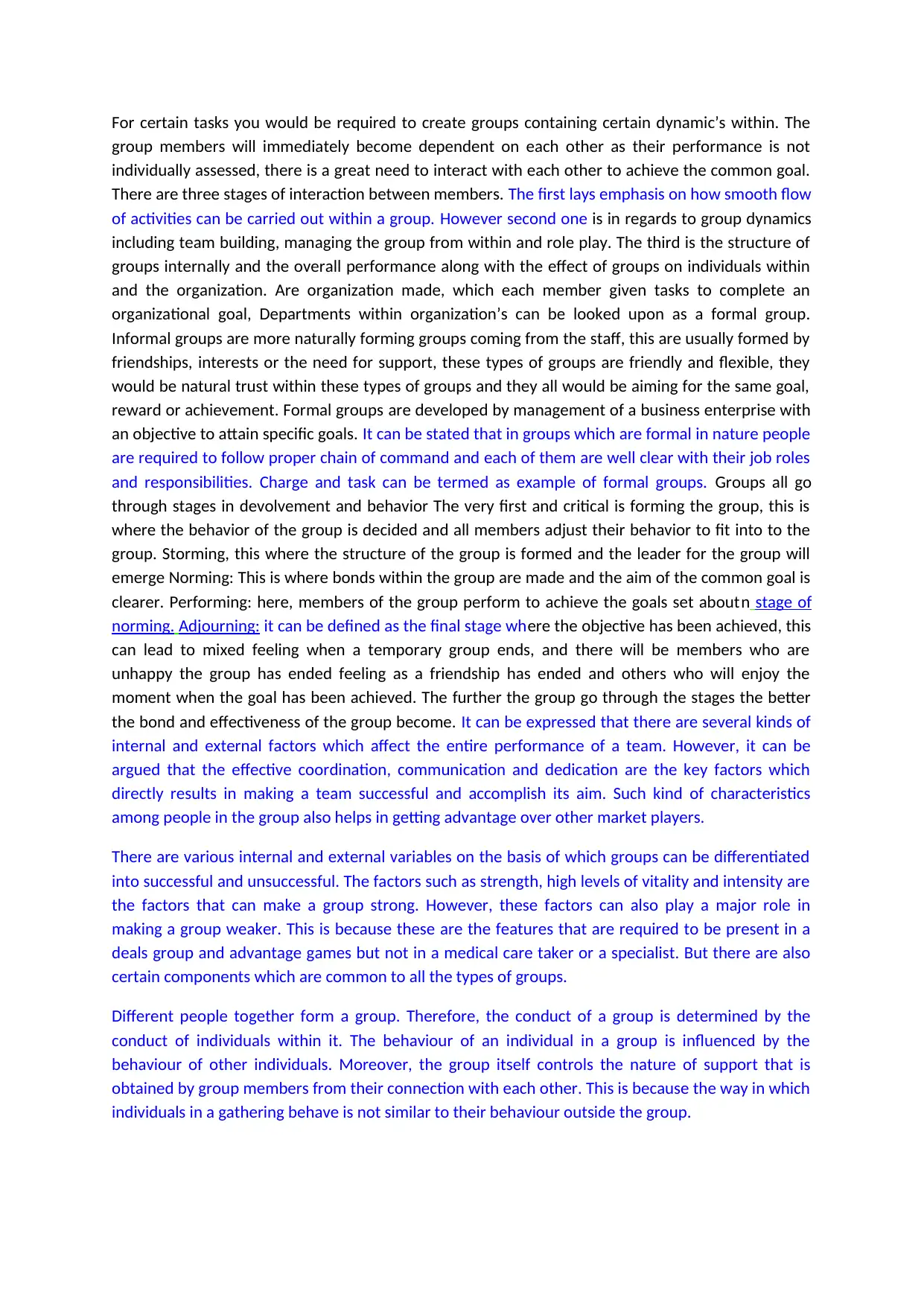
For certain tasks you would be required to create groups containing certain dynamic’s within. The
group members will immediately become dependent on each other as their performance is not
individually assessed, there is a great need to interact with each other to achieve the common goal.
There are three stages of interaction between members. The first lays emphasis on how smooth flow
of activities can be carried out within a group. However second one is in regards to group dynamics
including team building, managing the group from within and role play. The third is the structure of
groups internally and the overall performance along with the effect of groups on individuals within
and the organization. Are organization made, which each member given tasks to complete an
organizational goal, Departments within organization’s can be looked upon as a formal group.
Informal groups are more naturally forming groups coming from the staff, this are usually formed by
friendships, interests or the need for support, these types of groups are friendly and flexible, they
would be natural trust within these types of groups and they all would be aiming for the same goal,
reward or achievement. Formal groups are developed by management of a business enterprise with
an objective to attain specific goals. It can be stated that in groups which are formal in nature people
are required to follow proper chain of command and each of them are well clear with their job roles
and responsibilities. Charge and task can be termed as example of formal groups. Groups all go
through stages in devolvement and behavior The very first and critical is forming the group, this is
where the behavior of the group is decided and all members adjust their behavior to fit into to the
group. Storming, this where the structure of the group is formed and the leader for the group will
emerge Norming: This is where bonds within the group are made and the aim of the common goal is
clearer. Performing: here, members of the group perform to achieve the goals set aboutn stage of
norming. Adjourning: it can be defined as the final stage where the objective has been achieved, this
can lead to mixed feeling when a temporary group ends, and there will be members who are
unhappy the group has ended feeling as a friendship has ended and others who will enjoy the
moment when the goal has been achieved. The further the group go through the stages the better
the bond and effectiveness of the group become. It can be expressed that there are several kinds of
internal and external factors which affect the entire performance of a team. However, it can be
argued that the effective coordination, communication and dedication are the key factors which
directly results in making a team successful and accomplish its aim. Such kind of characteristics
among people in the group also helps in getting advantage over other market players.
There are various internal and external variables on the basis of which groups can be differentiated
into successful and unsuccessful. The factors such as strength, high levels of vitality and intensity are
the factors that can make a group strong. However, these factors can also play a major role in
making a group weaker. This is because these are the features that are required to be present in a
deals group and advantage games but not in a medical care taker or a specialist. But there are also
certain components which are common to all the types of groups.
Different people together form a group. Therefore, the conduct of a group is determined by the
conduct of individuals within it. The behaviour of an individual in a group is influenced by the
behaviour of other individuals. Moreover, the group itself controls the nature of support that is
obtained by group members from their connection with each other. This is because the way in which
individuals in a gathering behave is not similar to their behaviour outside the group.
group members will immediately become dependent on each other as their performance is not
individually assessed, there is a great need to interact with each other to achieve the common goal.
There are three stages of interaction between members. The first lays emphasis on how smooth flow
of activities can be carried out within a group. However second one is in regards to group dynamics
including team building, managing the group from within and role play. The third is the structure of
groups internally and the overall performance along with the effect of groups on individuals within
and the organization. Are organization made, which each member given tasks to complete an
organizational goal, Departments within organization’s can be looked upon as a formal group.
Informal groups are more naturally forming groups coming from the staff, this are usually formed by
friendships, interests or the need for support, these types of groups are friendly and flexible, they
would be natural trust within these types of groups and they all would be aiming for the same goal,
reward or achievement. Formal groups are developed by management of a business enterprise with
an objective to attain specific goals. It can be stated that in groups which are formal in nature people
are required to follow proper chain of command and each of them are well clear with their job roles
and responsibilities. Charge and task can be termed as example of formal groups. Groups all go
through stages in devolvement and behavior The very first and critical is forming the group, this is
where the behavior of the group is decided and all members adjust their behavior to fit into to the
group. Storming, this where the structure of the group is formed and the leader for the group will
emerge Norming: This is where bonds within the group are made and the aim of the common goal is
clearer. Performing: here, members of the group perform to achieve the goals set aboutn stage of
norming. Adjourning: it can be defined as the final stage where the objective has been achieved, this
can lead to mixed feeling when a temporary group ends, and there will be members who are
unhappy the group has ended feeling as a friendship has ended and others who will enjoy the
moment when the goal has been achieved. The further the group go through the stages the better
the bond and effectiveness of the group become. It can be expressed that there are several kinds of
internal and external factors which affect the entire performance of a team. However, it can be
argued that the effective coordination, communication and dedication are the key factors which
directly results in making a team successful and accomplish its aim. Such kind of characteristics
among people in the group also helps in getting advantage over other market players.
There are various internal and external variables on the basis of which groups can be differentiated
into successful and unsuccessful. The factors such as strength, high levels of vitality and intensity are
the factors that can make a group strong. However, these factors can also play a major role in
making a group weaker. This is because these are the features that are required to be present in a
deals group and advantage games but not in a medical care taker or a specialist. But there are also
certain components which are common to all the types of groups.
Different people together form a group. Therefore, the conduct of a group is determined by the
conduct of individuals within it. The behaviour of an individual in a group is influenced by the
behaviour of other individuals. Moreover, the group itself controls the nature of support that is
obtained by group members from their connection with each other. This is because the way in which
individuals in a gathering behave is not similar to their behaviour outside the group.
⊘ This is a preview!⊘
Do you want full access?
Subscribe today to unlock all pages.

Trusted by 1+ million students worldwide
1 out of 18
Related Documents
Your All-in-One AI-Powered Toolkit for Academic Success.
+13062052269
info@desklib.com
Available 24*7 on WhatsApp / Email
![[object Object]](/_next/static/media/star-bottom.7253800d.svg)
Unlock your academic potential
Copyright © 2020–2025 A2Z Services. All Rights Reserved. Developed and managed by ZUCOL.




